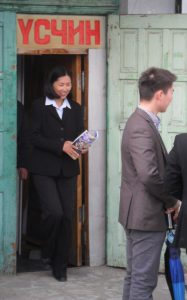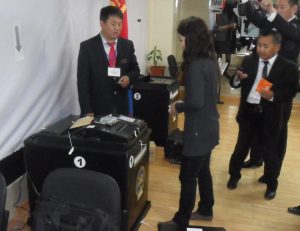Memo #168
By Julian Dierkes (julian.dierkes [at] ubc.ca) and Brandon Miliate (bmiliate [at] gmail.com)
*The figures in this Memo have been corrected from an earlier version
Mongolians voted in a parliamentary election on June 28, 2012 according to a new electoral system that mixed majoritarian and proportional representation. It also included a new quota requirement for women candidates.
The election law of 2012 specified that a minimum of 20 per cent of the candidates nominated and approved would be women. Five women were elected directly in the 48 first-past-the-post contests. Another four have been elected via proportional representation. These nine women will constitute 12 per cent of the members of parliament. This puts the Ikh Khural below the global average of 19.8 per cent of female parliamentarians according to the Inter-Parliamentary Union.
The requirement that parties insert women into the candidates’ lists meant that at least some of the 73 male incumbents had to seek candidacy in a difficult riding or a low party list ranking.
In fact, of the five women directly elected, four are newcomers to parliament. Three of the proportional representatives are also entering parliament for the first time. Over half of the new members of parliament elected in majoritarian districts will be new to the chamber.
Women politicians clearly made important gains. Few of the 11 parties contesting the election exceeded the quota of 20 per cent women by much. The 12 per cent share of seats suggests that female candidates were elected on average at below the rate that they were nominated. But there is some variability among the parties. The Mongolian People’s Party (MPP) put almost all women candidates towards the bottom of the party’s proportional representation list. Accordingly, only one of the nine female MPs will be from the MPP, with the possibility of one more following an upcoming run-off election. By contrast, five women will be representing the Democratic Party (DP) in the Ikh Khural.
Coming into the parliament with most seats the DP will likely be involved in forming a government. The composition of cabinet and assignments to chair standing committees will be the next test of women’s inclusion in political decision-making.
It appears that Mongolia is on a path to equal representation of women among its political leadership.
About the Authors:
Julian Dierkes – Keidanren Chair in Japanese Research, Institute of Asian Research, The University of British Columbia.
Brandon Miliate – graduate of Master of Arts – Asia Pacific Policy Studies (MAAPPS), The University of British Columbia.
Links:
- An extended version of the Memo is available on Mongolia Today, “The Impact of a Quota: Female MPs in the Ikh Khural,” July 3, 2012. (Blog post by Julian Dierkes).
- Women in National Parliaments, Inter-Parliamentary Union, May 2012.
- Seat Distribution Based on Corrected June 30 Preliminary Results, Mongolia Today, June 30, 2012. (Blog post by Julian Dierkes)
- Mongolia Today. (Blog by Julian Dierkes on information and analysis of contemporary Mongolia)
- Pintrest: Mongolian Parliamentary Election 2012.
Related Memos:
- See Julian Dierkes and Mendee Jargalsaikhan’s Memo, Mongolian Election: Bumpy Road, but Heading in the Right Direction (Memo #161)
- Our other Memos on Mongolia.


